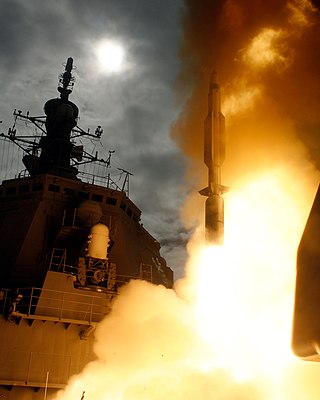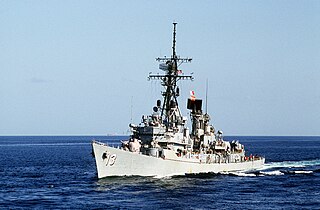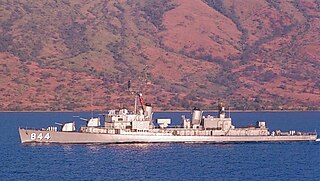
USS Winston S. Churchill (DDG-81) is an Arleigh Burke-class destroyer of the United States Navy. She is named after Sir Winston Churchill, former Prime Minister of the United Kingdom. This ship is the 31st destroyer of her class. Winston S. Churchill was the 18th ship of this class to be built at Bath Iron Works in Bath, Maine, and construction began on 7 May 1998. She was launched and christened on 17 April 1999. On 10 March 2001, she was commissioned during a ceremony at Town Point Park in Norfolk, Virginia.

A guided-missile destroyer (DDG) is a destroyer whose primary armament is guided missiles so they can provide anti-aircraft warfare screening for the fleet. The NATO standard designation for these vessels is DDG, while destroyers which have a primary gun armament and/or a small number of anti-aircraft missiles sufficient only for point-defense are designated DD. Nations vary in their use of destroyer D designation in their hull pennant numbering, either prefixing or dropping it altogether.

USS John King (DD-953/DDG-3) was a Charles F. Adams-class guided missile armed destroyer in the United States Navy named for Medal of Honor recipient John King.

USS Lawrence (DD-954/DDG-4) was a Charles F. Adams class guided-missile destroyer in the United States Navy. It was the fifth ship named after Captain James Lawrence USN (1781–1813). The USS Lawrence served on blockade duty during the Cuban Missile Crisis in October 1962 and, in 1972, was part of Operation Linebacker in the west Pacific.

USS Richard E. Byrd (DDG-23), a Charles F. Adams-class guided missile destroyer of the United States Navy, was named after noted polar explorer Admiral Richard E. Byrd.

USS Ticonderoga (DDG/CG-47), nicknamed "Tico", was a guided-missile cruiser built for the United States Navy. She was the lead ship of the Ticonderoga-class and the first U.S. Navy combatant to incorporate the Aegis combat system. Originally ordered as a guided-missile destroyer, she was redesignated as a cruiser after capabilities from the cancelled Strike cruiser program were implemented into the ship's design. The new AEGIS system allowed Ticonderoga to track and engage many aerial targets more effectively than any previous U.S. Navy warship.

USS Orleck (DD-886), is a Gearing-class destroyer that was in service with the United States Navy from 1945 to 1982. In October 1982 she was sold to Turkey and renamed Yücetepe. After her final decommissioning the Turkish government transferred Yücetepe to the Southeast Texas War Memorial and Heritage Foundation at Orange, Texas, where she was berthed as a museum ship. The Orleck Foundation then decided to move the ship to the Calcasieu River in Lake Charles, Louisiana. On 26 March 2022, she arrived in Jacksonville, FL, where she will serve as a Naval Museum on the downtown riverfront.

USS Sampson (DDG-10), named for Admiral William T. Sampson USN (1840–1902), was a Charles F. Adams-class guided missile destroyer in the United States Navy.

USS Robison (DDG-12), named for Rear Admiral Samuel Shelburne Robison, was a Charles F. Adams-class guided missile armed destroyer in the service of the United States Navy.

USS Tattnall (DDG-19) was a Charles F. Adams-class guided missile-armed destroyer of the United States Navy. She was named for Commodore Josiah Tattnall III USN (1794–1871) – also commandant of the CSS Virginia, and an admiral in the Confederate States Navy – who made the adage "blood is thicker than water" a part of American history.

USS Semmes (DDG-18), was the second Navy ship named for Commander (USN), Rear Admiral (CSN), Brigadier General (CSA) Raphael Semmes (1809–1877). Semmes was a Charles F. Adams-class guided-missile destroyer of the United States Navy. Entering service in 1962, Semmes spent most of her career in the Atlantic and Mediterranean theaters. Decommissioned in 1991, Semmes was transferred to the Hellenic Navy and renamed Kimon. The destroyer was decommissioned for the final time in 2004 and sold for scrap in 2006.

USS Hoel (DDG-13), named for Lieutenant Commander William R. Hoel USN (1824–1879), was a Charles F. Adams-class guided missile destroyer.

USS Mitscher (DL-2/DDG-35), named for Admiral Marc "Pete" Mitscher USN (1887–1947), was the lead ship of her class of destroyer leaders of the United States Navy. Commissioned in 1953, she was later converted to a guided missile destroyer, and served until 1978. She was sold for scrap in 1980.

The Charles F. Adams class is a ship class of 29 guided-missile destroyers (DDG) built between 1958 and 1967. Twenty-three were built for the United States Navy, three for the Royal Australian Navy, and three for the West German Bundesmarine. The design of these ships was based on that of Forrest Sherman-class destroyers, but the Charles F. Adams class were the first class designed to serve as guided-missile destroyers. 19 feet (5.8 m) of length was added to the center of the design of the Forrest Sherman class to carry the ASROC launcher. The Charles F. Adams-class were the last steam turbine-powered destroyers built for the U.S. Navy. Starting with the succeeding Spruance-class, all U.S. Navy destroyers have been powered by gas turbines. Some of the U.S. Charles F. Adams class served during the blockade of Cuba in 1962 and during the Vietnam War; those of the Royal Australian Navy served during the Vietnam War and Gulf War.

Naval Station Mayport is a major United States Navy base in Jacksonville, Florida. It contains a protected harbor that can accommodate aircraft carrier-size vessels, ship's intermediate maintenance activity (SIMA) and a military airfield with one asphalt paved runway (5/23) measuring 8,001 ft × 200 ft.

USS The Sullivans (DDG-68) is an Arleigh Burke-class Aegis guided missile destroyer. She is the second ship of the United States Navy to be named for the five Sullivan brothers – George, Francis, Joseph, Madison, and Albert Sullivan, aged 20 to 27 – who lost their lives when their ship, USS Juneau, was sunk by a Japanese submarine in November 1942 in the Naval Battle of Guadalcanal. This was the greatest military loss by any one American family during World War II.

USS Carney (DDG-64) is the 14th Arleigh Burke-class destroyer in the United States Navy. The ship is the first to be named after Admiral Robert Carney who served as Chief of Naval Operations during the Eisenhower administration.

USS Roosevelt (DDG-80) is an Arleigh Burke-class destroyer in service with the United States Navy. She is named in honor of both President Franklin D. Roosevelt and his wife, the then-First Lady Eleanor Roosevelt. This ship is the 30th destroyer of her class. USS Roosevelt was the 13th ship of this class to be built at Ingalls Shipbuilding in Pascagoula, Mississippi, and construction began on 15 December 1997. She was launched on 10 January 1999 and was christened on 23 January 1999. On 14 October 2000 the commissioning ceremony was held at Naval Station Mayport, Florida.

USS Perry (DD-844) was a Gearing-class destroyer of the United States Navy, the fourth Navy ship of that name and the fifth named for Commodore Oliver Hazard Perry (1785–1819), victor of the Battle of Lake Erie during the War of 1812 and one of the early heroes of the U.S. Navy.



















